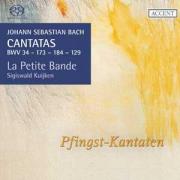Texte paru dans: / Appeared in:
*

International Record Review - (11//2013)
Pour
s'abonner / Subscription information
Accent
ACCSA25316

Code-barres / Barcode : 4015023253162
This disc is the sixteenth volume of Sigiswald Kuijken’s and his colleagues’ recording project of a complete cycle of Bach cantatas for all the Sundays and high feasts of a whole liturgical year. Thus, unlike Ton Koopman and Masaaki Suzuki, Kuijken and his team do not intend to record the complete Bach cantatas. With this volume, they have reached Pentecost, 50 days after Easter: BWV34, 173 and 184 were written for the three days of Pentecost (respectively in the 1740s, 1724 and 1730 or so) and BWV129 was for the first Sunday after Pentecost, known as Trinity Sunday (in 1 726 or 1 727). Only this last was a completely new work, the rest being Bach’s arrangements of earlier works for a wedding, a birthday and a New Year’s Day celebration during his period in Köthen from 1717 to 1723.
I went to bed last night listening to this disc on my headphones and must have quickly fallen asleep since I have no recollection of listening to anything after the opening chorus of the cantata O ewiges Feuer (BWV34). I awoke suddenly and disquieted in the dark. The tenor aria, ‘Glück und Siegen sind bereit’, of Erwünschtes Freudenlicht, BWV1 84 (track 15) was playing . It is sung by Christoph Genz, who is a most unappealing singer and it is baffling why Kuijken has used him on all but four discs of the series so far. His voice is grating and strangled; but worse is his unsteady tone, erratic volume, alarmingly wavering pitch and, on occasion, strangely sagging vibrato. In Bach’s trills and other rapid passages, he mostly sounds laboured and off-balance (for example, in the recitative opening Erhöhtes Fleisch und Blut, BWV1 73). Moreover, in Bach’s beloved long melismatic passages (such as in the lengthy recitative preceding the ‘Glück und Siegen’ aria), Genz almost sings each note in isolation, nearly oblivious to its connnection with those preceding and following it and thus obscuring Bach’s soaring lines.
Kuijken adheres to the theory of one-voice per-part performance of Bach’s cantatas. Besides giving the ‘choir’ greater flexibility and responsiveness, this also means each voice is more prominent than in the traditional chamber choir of 12 or so singers. Kuijken’s expertly led instrumental forces are also reduced: two first and second violins apiece and a single viola, cello (smaller than the customary model and held ‘da spalla’ or across the chest instead of between the legs, as Kuijken discusses at length in his programme notes), basse de violon (slightly smaller than a violone) and organ, with occasional contributions from pairs of transverse flutes or oboes and a trio of trumpets with timpani. The resulting sound is lean but not at all undernourished, though the violins have an interestingly reedy tone.
Regrettably, with such reduced forces one bad singer can ruin not only his or her own solos but damage the choruses too. In the three Pentecost cantatas, the tenor, besides five recitatives (two quite lengthy and elaborate) and two arias, is prominent in many of the choruses in the three Pentecost cantatas , starting with a disappointing passage two minutes into the opening of BWV34, the disc’s very first track.
The other singers, by contrast, are all splendid, particularly with the attentive and polished accompaniment provided by the instruments. The soprano Gerlinde Sämann makes a delightful contribution to her sparkling successive duets with the bass Jan Van der Crabben and then Genz in BWV173 and with the mezzo Petra Noskaiová in BWV184. She also delivers a refined account of her gentle yet quite fond single aria, ‘Gelobet sei der Herr’, in BWV129. Even more remarkable are Noskaiová and Van der Crabben. Noskaiová has been an accomplished participant throughout the series and her three arias on this disc are models of Bach singing (most notably in BWV129, supported by Vinciane Baudhuin’s especially beautiful oboe d’amore playing); but Van der Crabben, whose attractive and supple voice was already impressive from the start, seems only to get better with each volume. His aria in BWV129 is a high point of the disc for his control and keenly intelligent phrasing.
In fact, BWV129 makes a superb conclusion to the recording. Although it has no solos or prominent choral passages for tenor, it owes its success to the high quality of the singing and playing overall rather than Genz’s virtual absence - as well as some of Bach’s best cantata music ever and Kuijken’s alert, perfectly judged direction.
As always with Accent, the recording is transparent and natural. However, this is a hybrid Super Audio CD, which means that, besides the stereo recording playable on a standard compact disc player, it also includes separate stereo and multi-channel versions in a high resolution format playable only on a dedicated SACD player or universal DVD player with SACD capability. On such a player, the greater detail revealed both in the voices and instruments and in the acoustic surrounding them gives the recording marginally greater immediacy.
Cliquez l'un ou l'autre
bouton pour découvrir bien d'autres critiques de CD
Click either button for many other reviews


